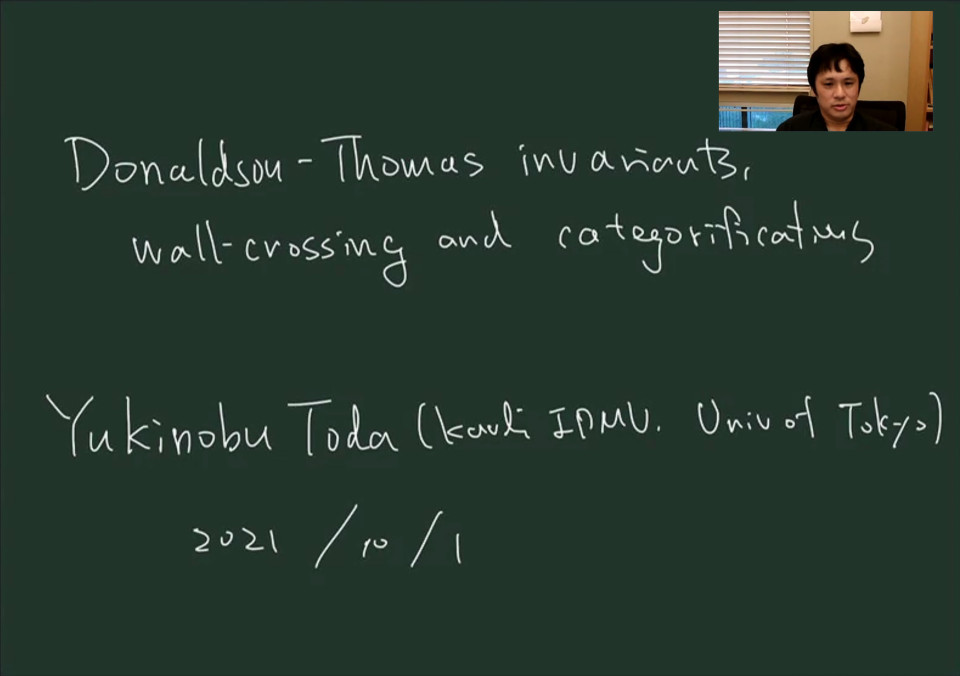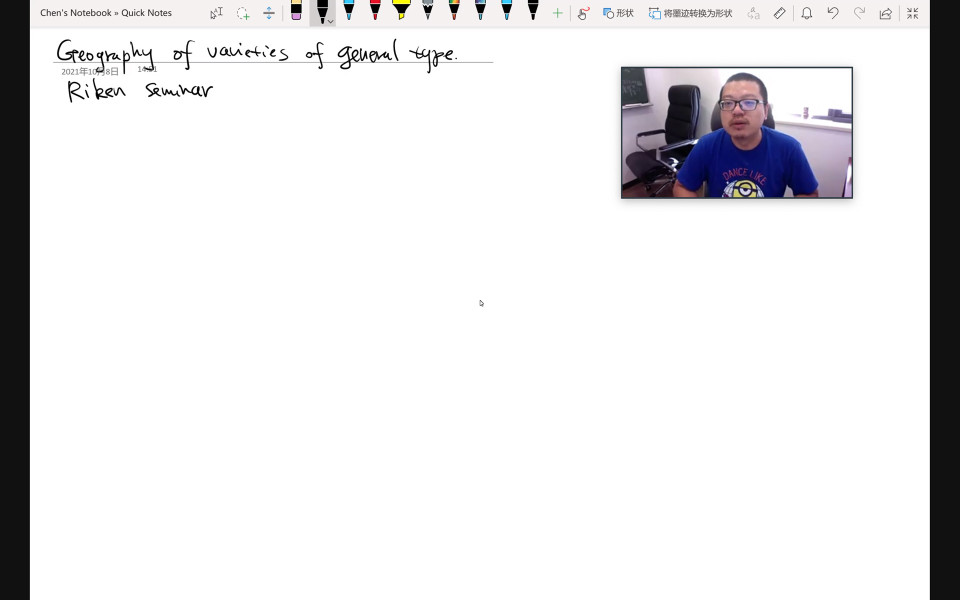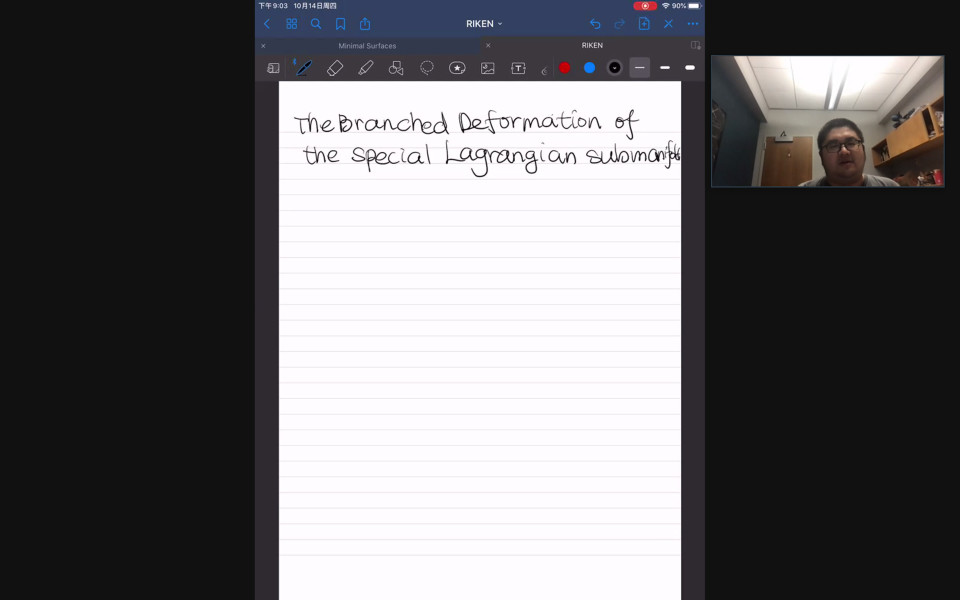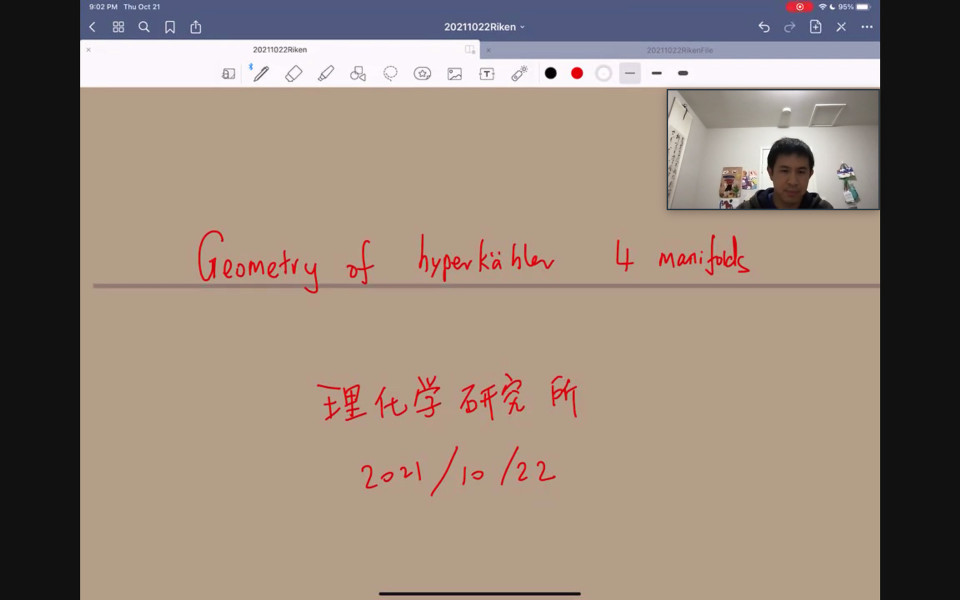Volume 176
Back to Newsletter List
Event Schedule
Events for the 1st week of December 2021
2021-11-25
Monday, November 29, 13:30– 15:00 Information Theory SG Seminar
Friday, December 3, 12:30- Coffee Meeting
Seminar Report
iTHEMS Math Seminar by Prof. Yukinobu Toda on October 1, 2021
2021-11-24
In this seminar, Professor Yukinobu Toda started with the example of counting rational curves on hypersurfaces in complex projective spaces to illustrate ideas in enumerative geometry. Then he introduced several advanced topics including Donaldson-Thomas theory and mirror symmetry. Finally he explained his recent work on wall-crossing formulae for categorified DT invariants on resolved conifold.
Reported by Yalong Cao
Donaldson-Thomas invariants, wall-crossing and categorifications
October 1 (Fri) 16:00 - 18:10, 2021
Seminar Report
iTHEMS Math Seminar by Prof. Chen Jiang on October 8, 2021
2021-11-24
In this seminar, Professor Chen Jiang started with several basic notions like geometric genus and canonical volume in birtaional geometry and introduced the question of geography problem. On algebraic surfaces, the boundary of geography problem is given by Miyaoka-Yau inequality and Noether inequality. Then he explained generalizations of the story on 3-folds, including his joint work with M. Chen and J.K.Chen. Finally he gave an outline for the proof of his main theorem.
Reported by Yalong Cao
Geography of varieties of general type
October 8 (Fri) 16:00 - 18:10, 2021
Seminar Report
iTHEMS Math Seminar by Prof. Siqi He on October 15, 2021
2021-11-24
In this seminar, Professor Siqi He started with mean curvatures and minimal submanifolds in differential geometry. Then he introduced the notion of calibrated geometry of Harvey-Lawson. As important examples of calibrated submanifolds, special Lagrangian submanifolds in Calabi-Yau manifolds are introduced. Then he explained a branch cover problem raised by Simon Donaldson and sketched a proof of it.
Reported by Yalong Cao
The branched deformations of special Lagrangian submanifolds
October 15 (Fri) 10:00 - 12:00, 2021
Seminar Report
iTHEMS Math Seminar by Prof. Song Sun on October 22, 2021
2021-11-24
In this seminar, Professor Song Sun started with explaining the most basic concepts like, Riemannian metric, curvature in differential geometry. He then introduced one of the most important equations differential geometry, the so-called Einstein equation. After defining the holonomy group of a Riemannian manifold, he explained Berger's classification of holonomy groups of Riemannian manifolds which are not locally symmetric. He then pointed out the importance of studying Riemannian manifolds with special/exceptional holonomy groups, e.g. Calabi-Yau manifolds, hyperkahler manifolds, G2 and Spin(7) manifolds. He concentrated on hyperkahler 4-manifolds and explained their geometry and topology in more details. In the end, he introduced his recent research result on studying Gromov-Hausdorff limit of hyperkahler 4-manifolds.
Reported by Yalong Cao
Geometry of hyperkahler 4 manifolds
October 22 (Fri) 13:00 - 15:00, 2021
Upcoming Events
Seminar
iTHEMS Math Seminar
Self-adjointness from quantum-classical correspondence
November 26 (Fri) 16:00 - 18:00, 2021
Koichi Taira (Assistant Professor, College of Science and Engineering Department of Mathematical Sciences, Ritsumeikan University)
Self-adjointness is a fundamental property of a linear operator in quantum mechanics. In physics, a self-adjoint operator is usually defined to be an operator which is own adjoint. However, this definition is in fact not satisfactory since a self-adjoint operator in this definition does not always have nice properties such as the spectral decomposition. Hence, in mathematics, a kind of completeness is also assumed in the definition of a self-adjoint operator. Here a natural question is how to judge whether an operator is self-adjoint. It has been believed that self-adjointness is closely related to completeness of the classical dynamics for a long time although a complete description of such relations has not been given so far. I am planning to talk about how self-adjointness is important in mathematical physics. Moreover, I will explain relations between self-adjointness and classical dynamics by introducing some examples.
*Please contact Keita Mikami or Hiroyasu Miyazaki's mailing address to get access to the Zoom meeting room.
Venue: via Zoom
Event Official Language: English
Seminar
Information Theory Seminar
Simulation-based inference for multi-type cortical circuits
November 29 (Mon) 13:30 - 15:00, 2021
Enrico Rinaldi (Research Fellow, Physics Department, University of Michigan, USA)
In many scientific fields, ranging from astrophysics to particle physics and neuroscience, simulators for dynamical systems generate a massive amount of data. One of the crucial tasks scientists are spending their precious time on is comparing observational data to the aforementioned simulations in order to infer physically relevant parameters and their uncertainties, based on the model embedded in the simulator. This poses a problem because the likelihood function for realistic simulations of complex physical systems is intractable. Simulation-based inference techniques attack this problem using machine learning tools and probabilistic programming. I will start with an overview of the problem and explain the general application of simulation-based inference methods. Then I will describe an application of the methods to a model of neurons in the visual cortex of mice."
References
- Kyle Cranmer, Johann Brehmer, Gilles Louppe, The frontier of simulation-based inference, PNAS 117, 48, 30055-30062 (2020), doi: 10.1073/pnas.1912789117
- Agostina Palmigiano, Francesco Fumarola, Daniel P. Mossing, Nataliya Kraynyukova, Hillel Adesnik, Kenneth D. Miller, Structure and variability of optogenetic responses identify the operating regime of cortex (2021), doi: 10.1101/2020.11.11.378729
Venue: via Zoom
Event Official Language: English
Seminar
iTHEMS Biology Seminar
Selective inference for testing trees and edges in hierarchical clustering and phylogeny
December 9 (Thu) 10:00 - 11:00, 2021
Hidetoshi Shimodaira (Professor, Graduate School of Informatics, Kyoto University / Team Leader, Mathematical Statistics Team, RIKEN Center for Advanced Intelligence Project (AIP))
Bootstrap resampling is quite useful for computing “confidence values” or “p-values” of trees and edges. However, they are biased and may lead to false positives (too many wrong discoveries) or false negatives (too few correct discoveries) depending on the “curvature” of the boundary surface of a hypothesis region in the data space. In addition, we face the issue of selection bias because we tend to use the dataset twice for hypothesis selection and its evaluation. I will explain these two types of bias and show methods to adjust the confidence values.
Reference
- Hidetoshi Shimodaira and Yoshikazu Terada, Selective Inference for Testing Trees and Edges in Phylogenetics, Front. Ecol. Evol., 24 (2019), doi: 10.3389/fevo.2019.00174
Venue: via Zoom
Event Official Language: English
Seminar
DMWG Seminar
The FASER experiment
December 15 (Wed) 17:00 - 18:00, 2021
Hidetoshi Otono (Assistant Professor, Research Center for Advanced Particle Physics, Kyushu University)
FASER, the ForwArd Search ExpeRiment, is an experiment dedicated to searching for light, extremely weakly-interacting particles at the LHC. Such particles may be produced in the LHC’s high-energy collisions and then decay to visible particles in FASER, which is placed 480 m downstream of the ATLAS interaction point. FASER, also includes a sub-detector, FASER$\nu$, designed to detect neutrino’s produced in the LHC collisions and to study their properties. This seminar will describe the physics motivations, detector design, expected performance of FASER, and current status, as well as the physics prospects.
Venue: via Zoom
Event Official Language: English
Paper of the Week
Week 4, November 2021
2021-11-25
Title: Factorizing Wormholes in a Partially Disorder-Averaged SYK Model
Author: Kanato Goto, Kenta Suzuki, Tomonori Ugajin
arXiv: http://arxiv.org/abs/2111.11705v1
If you would like to cancel your subscription or change your email address,
please let us know via our contact form.
Copyright © iTHEMS, RIKEN. All rights reserved.







